MARIANI’S
Virtual
Gourmet
JULY
28, 2019
NEWSLETTER
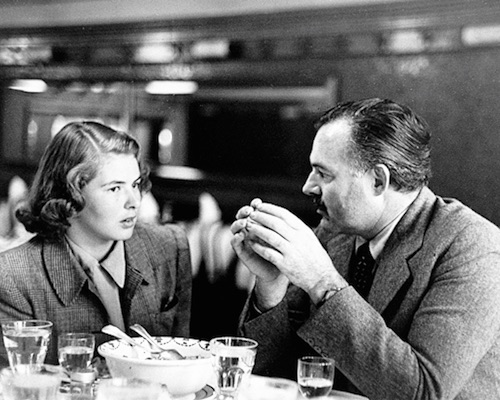
in 1941, prior to her agreeing to star in "For Whom the Bell Tolls"
❖❖❖
IN THIS ISSUE
TORDESILLAS, SPAIN
By John Mariani
NEW YORK CORNER
LOCALI
By John Mariani
NOTES FROM THE WINE CELLAR
WINES FOR SUMMER SIPPING
By Geoff Kalish
❖❖❖
TORDESILLAS, SPAIN
By John Mariani
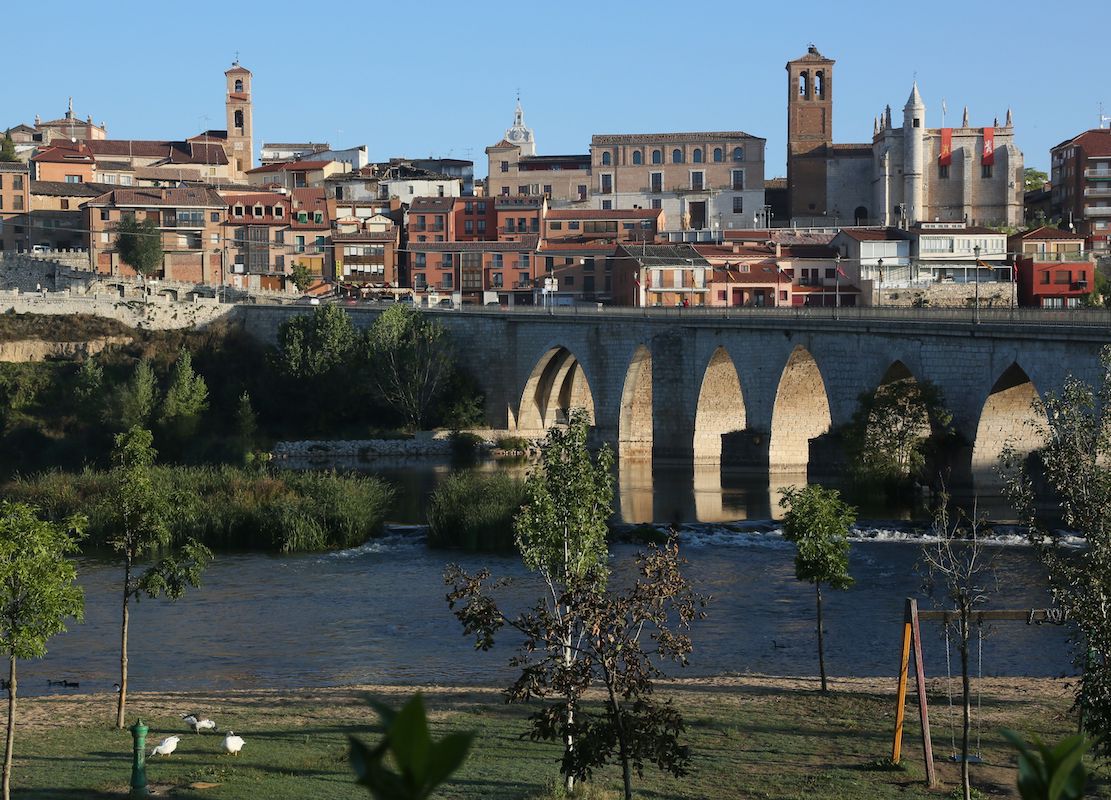
Photo by Gerry Dawes
Tordesillas
is not likely to show up as a prime destination
for most tourists in Spain, but in its own way,
both historically and in character, it is a calm
waystop between larger towns like Valladolid and
Burgos, with Madrid a two hours’ drive to the
south. With only 9,000 residents Tordesillas is
a pleasantly quiet place that gets some tourists
on weekends, and market days draws a crowd to
the center. You can walk for blocks through the
narrow streets and not meet more than a few
people along the way.
The Romans built a bulwark here
along the Douro River, and Alfonso XI built a
palace on the site in 1325; it was
here that The Catholic Monarchs signed
the Treaty of Tordesillas in 1494 that
set the Line of Demarcation dividing the globe
between Spain and Portugal for future
colonization.
You enter Tordesillas over a
Gothic arched stone bridge, park your car wherever
you can find a spot, and then just begin to wander
its lovely streets. The farther in you go towards
the beautiful Plaza Mayor, with its 17th
century colonnade and arcade, the
more local people you’ll find shopping in the old
food and clothing shops. The small 16th century
Church of Santa Maria is but a few steps away,
wedged into place, along with several other
churches, including San Juan, San Pedro,
Santiago, and San Antolín, this last, dating
to the 15th century, now holding a museum of
religious artwork of the area.
The Convent of Santa
Clara, near the river, is a striking
example of 14th century royal architecture (right), once
palace to Alfonso XI, later a nuns’ residence.
Sadly, it was here that Joanna I, daughter of
Queen Isabella and Queen of Castile and Aragon,
was imprisoned by her father, Ferdinand II, in
1509 and kept in the convent by her own son,
Charles I, until her death in 1555.
The winding streets leading to
the river are lined with new cafés and bakeries,
and at every turn you’ll meet a saint’s statue or
crucifix. There is also a statue of a raging bull,
the animal central to the controversial annual
Torneo del Toro de la Vega, in which horsemen
drove a bull to a meadow across the Douro,
slaughtered it with lances, cut off its testicles
and paraded them on a spear through the town. I
have neither seen nor wish to see something as
senseless as this, however traditional the event
is, and am happy the town’s mayor banned it in
2016.
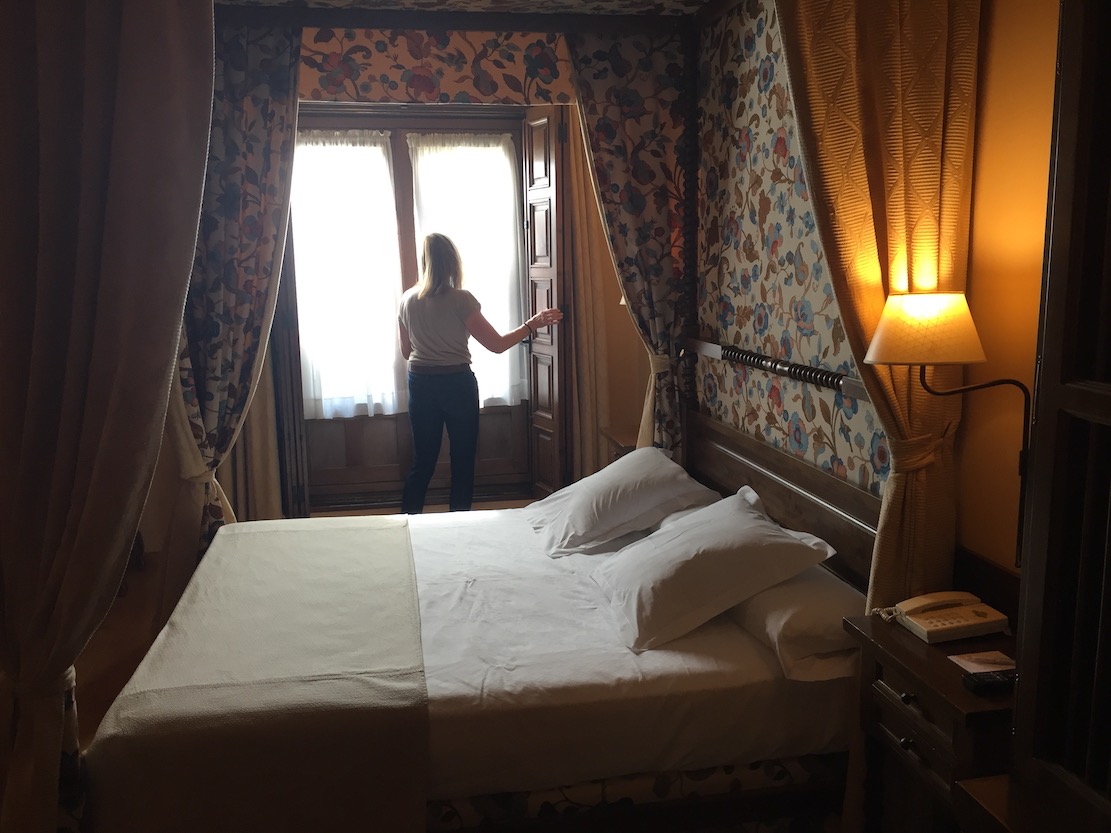 Tordesillas
has many good hotels, not least the sprawling El Parador
(left)
across the river (Ctra. De
Salamanca; +34 983-770-051), set within
woods whose pine trees slant gracefully toward the
sun. Its
Castilian architecture and Doric columns are
distinguished, its garden beautifully landscaped,
and it’s a welcoming place for families, with a
heated swimming pool, sauna and gym. I hadn’t the
chance to dine at the award-winning restaurant,
but it is as lovely as the rest of the property.
Tordesillas
has many good hotels, not least the sprawling El Parador
(left)
across the river (Ctra. De
Salamanca; +34 983-770-051), set within
woods whose pine trees slant gracefully toward the
sun. Its
Castilian architecture and Doric columns are
distinguished, its garden beautifully landscaped,
and it’s a welcoming place for families, with a
heated swimming pool, sauna and gym. I hadn’t the
chance to dine at the award-winning restaurant,
but it is as lovely as the rest of the property.
The two best restaurants in the
area are El
Torreón
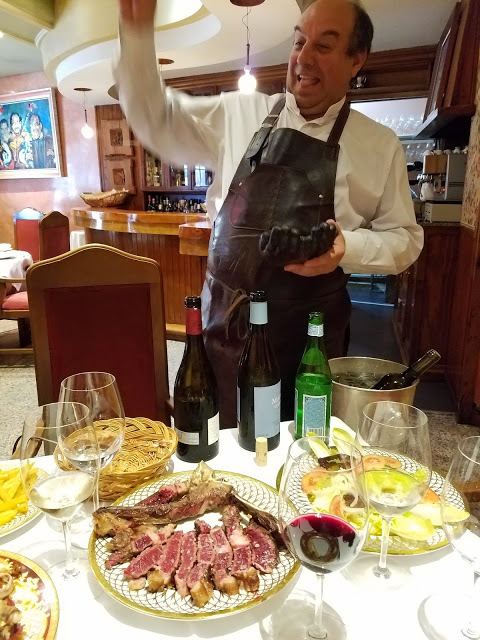 (Av.
Burgos-Portugal 11;
+34-679-155-046) and two doors away Alquira
(at number
15; +34 983-77-0640). The former, here for
more than four decades, is a flamboyant place with
an equally flamboyant chef-owner, Jeremias de
Lozar, a big, ever smiling exponent of the good
life as he sees it. Everything is big, from the
fiery open grill kitchen to the padded armchairs
to the portions of food; tablecloths are thick,
wine glasses ornately etched, the china gilded,
the artwork eclectic, the walls red, the historic
ceiling gold; there are heraldic motifs everywhere
and cow’s hides hung about; and there is a carving
of giant wooden hands holding a mound of sea salt.
Everything is created to make the guest a little
giddy, and no one leaves El Torreón
hungry.
Photo:
Gerry Dawes
(Av.
Burgos-Portugal 11;
+34-679-155-046) and two doors away Alquira
(at number
15; +34 983-77-0640). The former, here for
more than four decades, is a flamboyant place with
an equally flamboyant chef-owner, Jeremias de
Lozar, a big, ever smiling exponent of the good
life as he sees it. Everything is big, from the
fiery open grill kitchen to the padded armchairs
to the portions of food; tablecloths are thick,
wine glasses ornately etched, the china gilded,
the artwork eclectic, the walls red, the historic
ceiling gold; there are heraldic motifs everywhere
and cow’s hides hung about; and there is a carving
of giant wooden hands holding a mound of sea salt.
Everything is created to make the guest a little
giddy, and no one leaves El Torreón
hungry.
Photo:
Gerry Dawes
As is customary
in Spain, pa
amb tomàquet, a toasted piece of bread with
tomato spread on top, opens the meal. There are
also freshly cooked potato chips, warm mixed
vegetables and cheese patties with peppercorns
(6€). Those were merely first bites. Next came
translucent carpaccio of beef with foie gras,
shavings of cheese and chopped pickles (16.50€) .
More foie gras follows, this time with a reduction
of raisins as a sweet foil (28.50€).
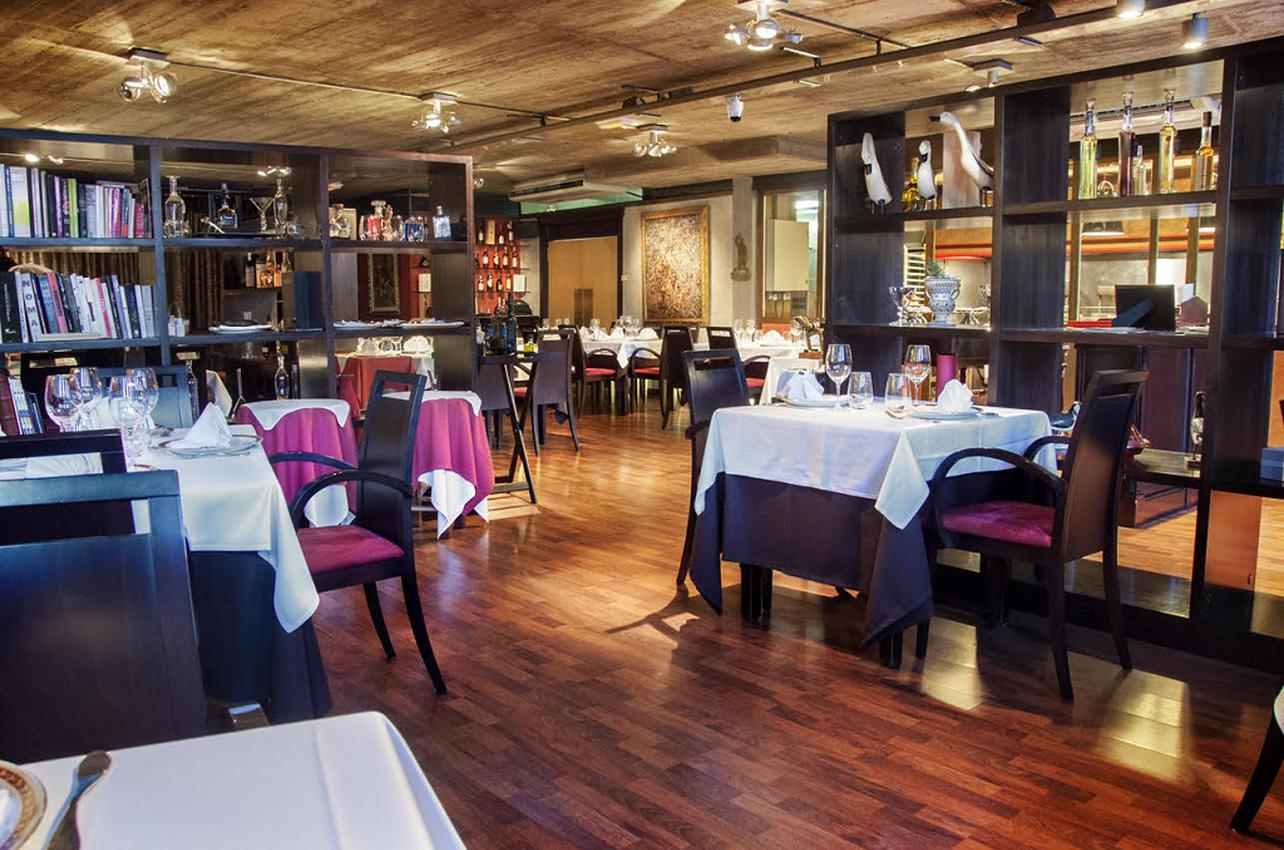 The table
filled up with portions of well marbled, very rare
beef served with perfectly ripened tomatoes and
onions (23.50€); and tender lamb riblets with red
peppers and tiny nubbins of garlic (23.50€). For
dessert was a simple dish of vanilla ice cream
with a cinnamon wafer (6€).
The table
filled up with portions of well marbled, very rare
beef served with perfectly ripened tomatoes and
onions (23.50€); and tender lamb riblets with red
peppers and tiny nubbins of garlic (23.50€). For
dessert was a simple dish of vanilla ice cream
with a cinnamon wafer (6€).
The wine list is a paean to
modern Iberian viticulture with prices for every
budget.
De Lózar, in his leather
butcher’s apron, will be bringing the food,
pouring the wine, making sure all is okay with
your meal. And he’ll probably tell you your next meal
should be at his sons’ place next door.
As vocal and operatic as de
Lózar is, his sons, Cristobal, Adolfo and Leo, 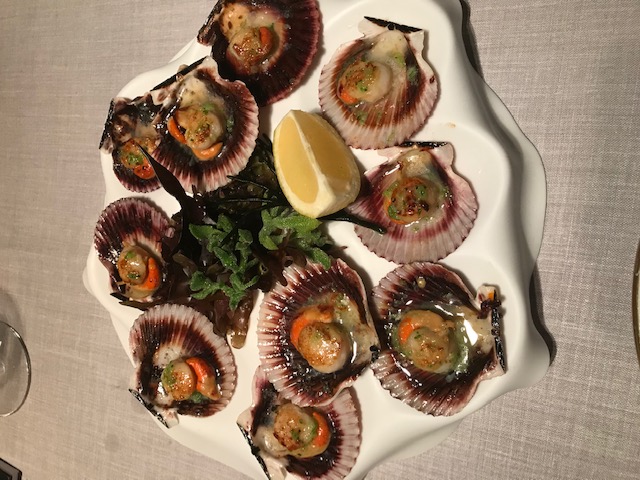 are more
genteel, quietly passionate but no less devoted to
their guest’s pleasures at Alquira (left). The
dining room and brightly lighted open kitchen are
as restrained as El Torreón’s are dramatic. As
modern as it looks, the wine cellar downstairs is
ancient and well worth a look-see.
are more
genteel, quietly passionate but no less devoted to
their guest’s pleasures at Alquira (left). The
dining room and brightly lighted open kitchen are
as restrained as El Torreón’s are dramatic. As
modern as it looks, the wine cellar downstairs is
ancient and well worth a look-see.
I left our meal in the young
men’s hands and began with luscious, barely cooked
sea scallops (right)
with their coral in their shells (20€), then
simply grilled calamari with a verdant mayonnaise
and dusted with plankton powder (19€). Flaky merluzo
(hake) was grilled juicy with a judicious amount
of garlic (21.50€).
For dessert there was a flan
made without milk, only eggs, so it was
exceptionally rich, and a dish of puff pastry
filled with whipped
cream.
Photo: Gerry
Dawes
Alquira also serves the
family’s beef, but if seafood is your wont, it is
every bit as delicious as the meats, and the
brothers are obviously very proud of that kind of
balance.
❖❖❖
By John Mariani
Photos: Matthew Mancuso
2 Kirby Plaza
Mt. Kisco, NY
914-242-0100
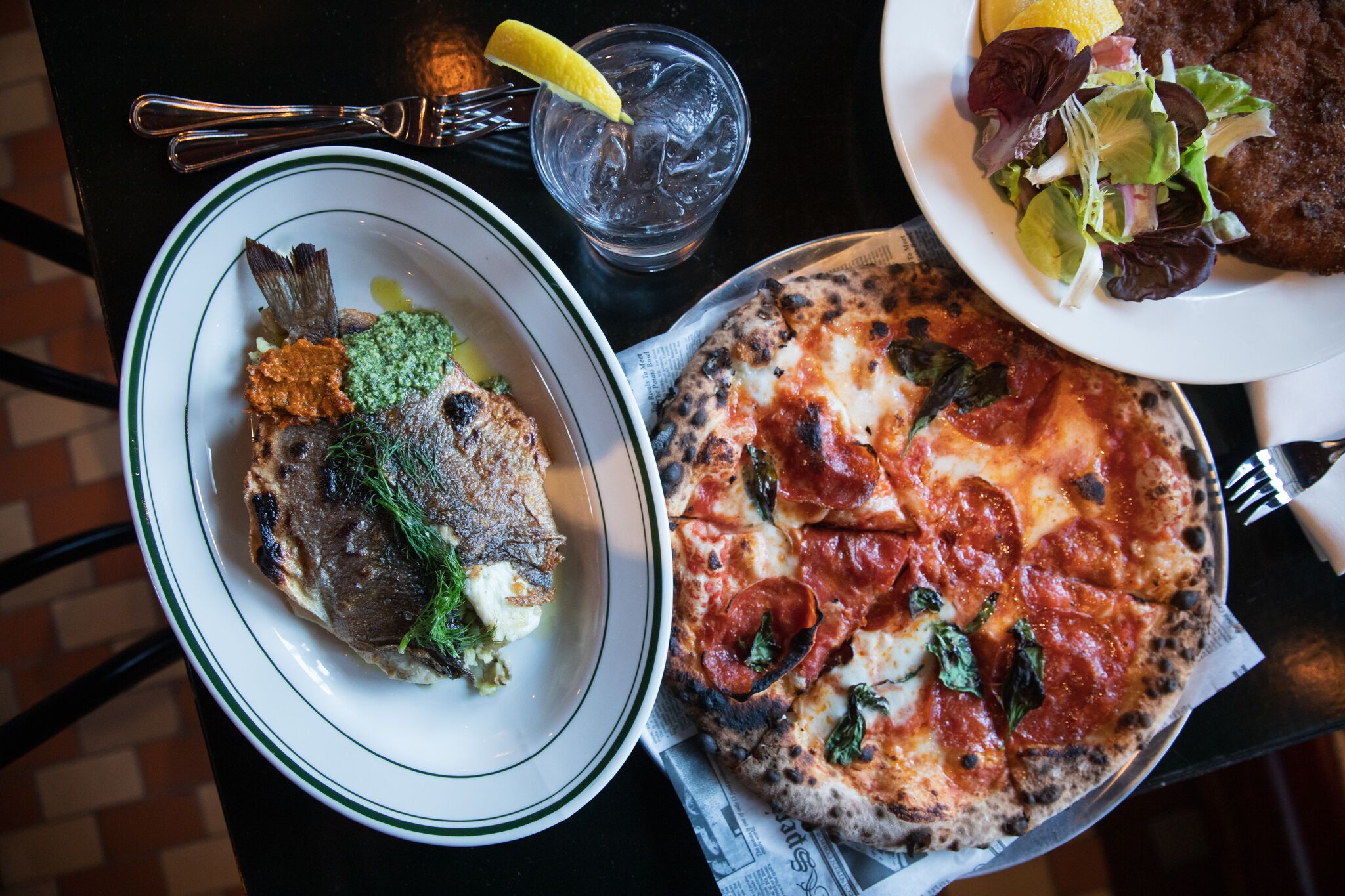
One of
the best things about New York City is that it
stops at the northern edge of The Bronx and has
never intruded, as in so many newer cities, into
what was once countryside and now is more
mundanely referred to as the suburbs. Westchester
County to the north is itself home to large
cities like New Rochelle, Mount Vernon and
Yonkers, all with their own urban problems, but
the farther you head up the Hudson and Harlem
lines of Metro North, the more the frantic pace
of the city recedes away from towns like Mount
Kisco, which was incorporated as a village in
1875.
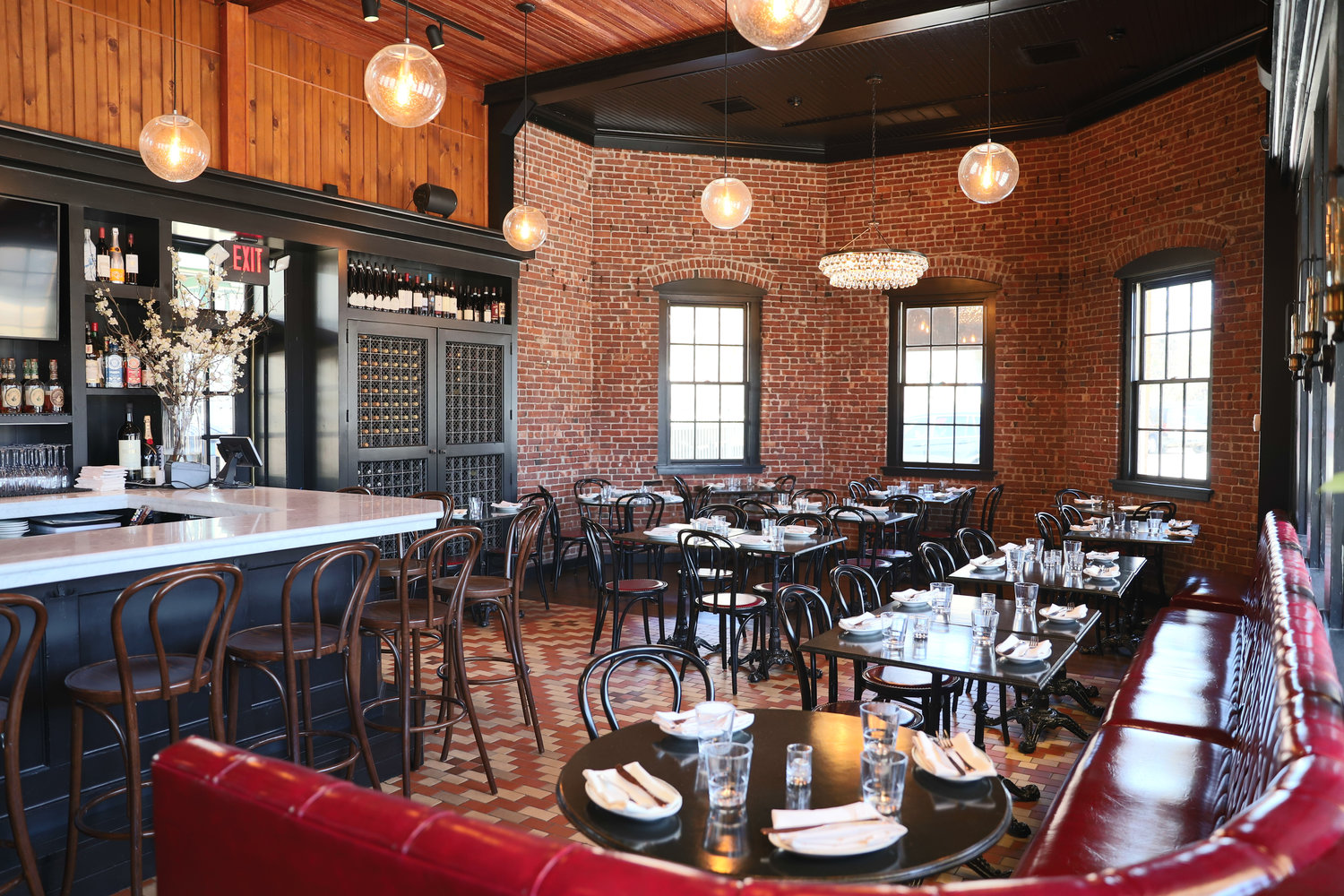 It was once
a cliché to say that restaurant options in ‘burbs
like Mt. Kisco were usually second-rate versions
of similar restaurants in Manhattan. But Locali,
which is handily located within the Mt. Kisco
train station, proves that the right owners with a
commitment to a high level of quality and service
both pays off and gives them bragging rights as
one of the best Italian restaurants north of the
city.
It was once
a cliché to say that restaurant options in ‘burbs
like Mt. Kisco were usually second-rate versions
of similar restaurants in Manhattan. But Locali,
which is handily located within the Mt. Kisco
train station, proves that the right owners with a
commitment to a high level of quality and service
both pays off and gives them bragging rights as
one of the best Italian restaurants north of the
city.
It’s a great-looking room,
appointed with dark red brick, tile floors, dark
wooden beams, evocative black-and-white railroad
photos, a handsome bar and bright red banquettes.
Locali is a very handy place to get a pizza or
other take-out food if you’re coming off the
train, but it’s a familial spot to dine as well,
with a service staff that gets to know the
neighbors.
The
pizzas are very good indeed, with a dozen options
($13-$21). The 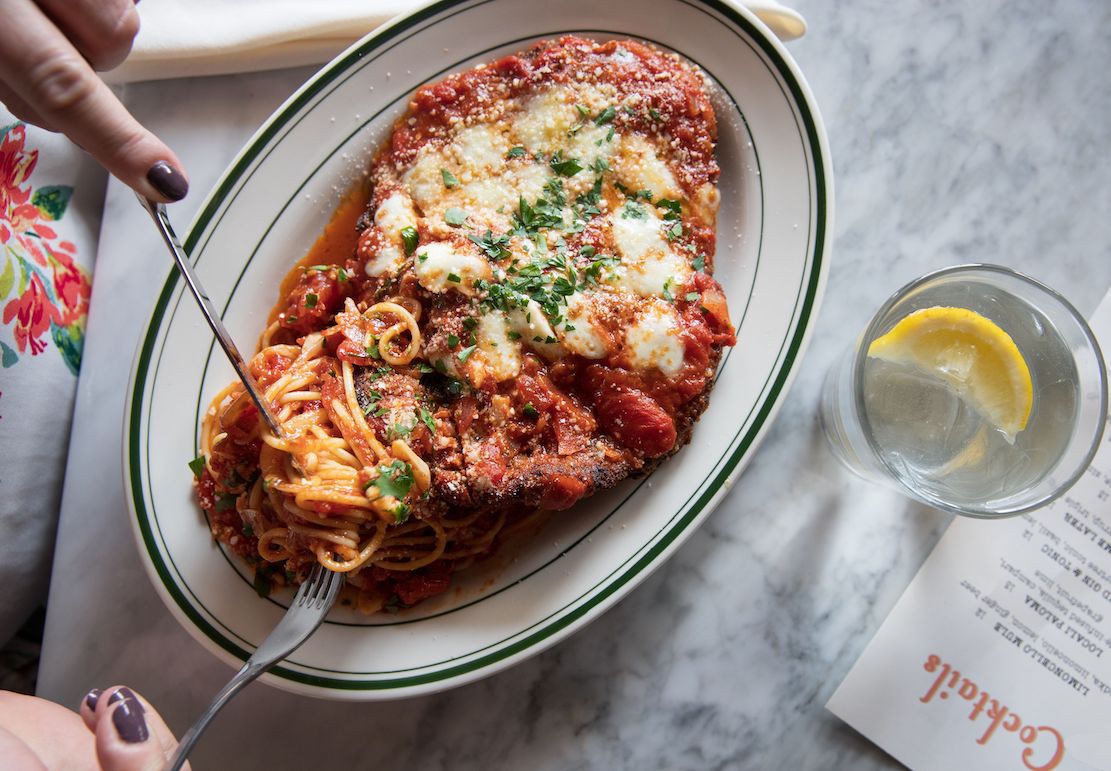 crusts are
both pliant and crisp, with nicely charred bubbles
of yeasty dough beneath very fresh-tasting
toppings that range from a basic "Queen Margarita"
(with “New Canaan olive oil”) to a spicy Calabria
with ‘nduja
and jalapeño, and a Gladiator pizza with egg,
tomato and bacon.
I recommend ordering one for the table, if
you’re going to have pasta and a main course next.
crusts are
both pliant and crisp, with nicely charred bubbles
of yeasty dough beneath very fresh-tasting
toppings that range from a basic "Queen Margarita"
(with “New Canaan olive oil”) to a spicy Calabria
with ‘nduja
and jalapeño, and a Gladiator pizza with egg,
tomato and bacon.
I recommend ordering one for the table, if
you’re going to have pasta and a main course next.
I sampled three out of the six
pastas ($17-$21), all generously portioned, from a
hefty plate of garganelli with a veal, beef and
pork ragù;
linguine with clams in the shell and with plenty
of garlic (as requested) and chili flakes; and
luscious eggplant ravioli with a fine marinara,
citrus-garlic oil, pecorino and basil.
In so many Italian restaurants, main
courses are sometimes an afterthought, but you
wouldn’t want to miss the flattened, crispy
Milanese-style pork chop with greens, capers and
pickled shallots ($26) or the 24-ounce short rib
with polenta, sweet-sour gremolata
and a delicious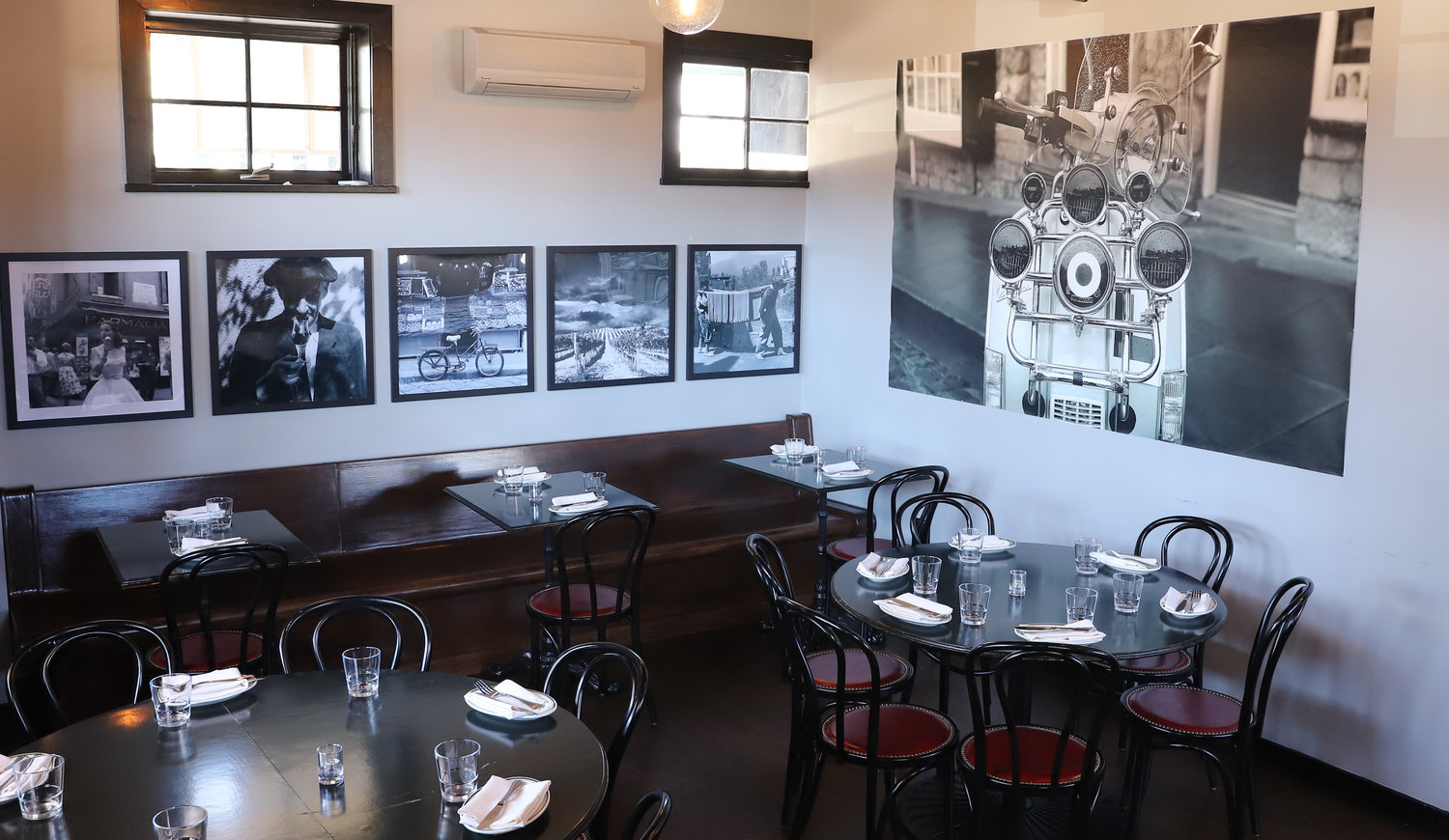 salsa verde
($28). If you prefer seafood, the kitchen knows
well how to treat branzino grilled over a
woodfire, making the skin crispy while leaving the
interior very juicy, served with a summer pesto of
basil and tomato, potatoes, herbs and lemon ($26).
salsa verde
($28). If you prefer seafood, the kitchen knows
well how to treat branzino grilled over a
woodfire, making the skin crispy while leaving the
interior very juicy, served with a summer pesto of
basil and tomato, potatoes, herbs and lemon ($26).
There’s Nutella pizza ($15) for dessert,
but the tiramisù
($8), chocolate budino pudding with hazelnut
crunch and whipped cream ($7) and ricotta
cheesecake ($8) are better choices. The warm olive
oil cake gets its real flavor from sun-dried
orange peel and a citrus sorbet ($8).
There are 12 wines by the glass
and 16 beers at the well-stocked bar, but the wine
list is only adequate, with a weak handful of
whites and a very safe selection of reds, though
the management is smart to keep the prices per
bottle largely under $50.
Is Locali worth
a drive from Manhattan? Very much so, if you
combine it with a lovely afternoon in Westchester
County’s lake country and Hudson Valley. And, if
you live in Westchester, you may find Locali a
first choice among Italian restaurants north of
the city.
Open daily for lunch or brunch and dinner, except Monday.
❖❖❖
By Geoff Kalish

À la Rodney
Dangerfield, “some wines just don’t get no
respect,” particularly whites best suited to sip
poolside or seaside with the likes of cheeses
like brie and camembert, crudités, pretzels,
chips and dips of guacamole, hummus or salsa.
Not that these wines can’t accompany a meal,
especially one dominated by seafare, but they
are generally not wines to ponder or pontificate
about—rather to quaff and just enjoy.
Also, while generally
well-priced, many of these “super sippers” are
often overlooked, because they are less well known
than their more elegant (and much more expensive)
cousins like Chablis, Sancerre and Chardonnay. So,
rather than just settling on a rosé, here are some
whites to sip when wearing a bathing suit.
Although there are more than a few light,
innocuous Portuguese whites available that seem
like bargains on store shelves and restaurant
lists, many are bland and dull and best used for
Sangria. However, I can recommend the following
three bottles as perfect to mate with poolside
and/or seaside hors d’oeuvres.
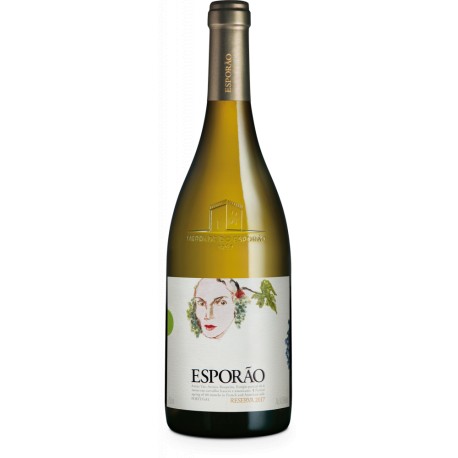 The 2017 Herade
do Rocim Mariana Branco ($14) is named for
Mariana Alcoforado, thought to have written the
classic book Love Letters
of a Portuguese Nun, and grapes for this
wine (60% Antao Vaz, 30% Arinto, 10% Alvarinho)
hail from the Lower Alentejo region in southern
Portugal. It shows a bouquet and taste of ripe
melons with a hint of pineapple and notes of lemon
in its smooth finish.
The 2017 Herade
do Rocim Mariana Branco ($14) is named for
Mariana Alcoforado, thought to have written the
classic book Love Letters
of a Portuguese Nun, and grapes for this
wine (60% Antao Vaz, 30% Arinto, 10% Alvarinho)
hail from the Lower Alentejo region in southern
Portugal. It shows a bouquet and taste of ripe
melons with a hint of pineapple and notes of lemon
in its smooth finish.
The 2018 Fita
Preta Branco ($22) was made from a blend of
hand–harvested Antao Vaz, Roupeiro and Arinto
grapes grown in the schist soil of the southern
Alentejo region. It has a bouquet and taste of
ripe citrus fruit with notes of honey in its long
finish.
The 2017
Esporão Reserva White ($20) is a blend of
Antao Vaz, Arinto and Rouperio grapes from the
Alentejo region. It shows a Sauvignon Blanc-like
bouquet and taste of grapefruit, lemon and a touch
of honey in its crisp finish.
Also, often
overlooked are the fragrant whites from the area
surrounding Lake Garda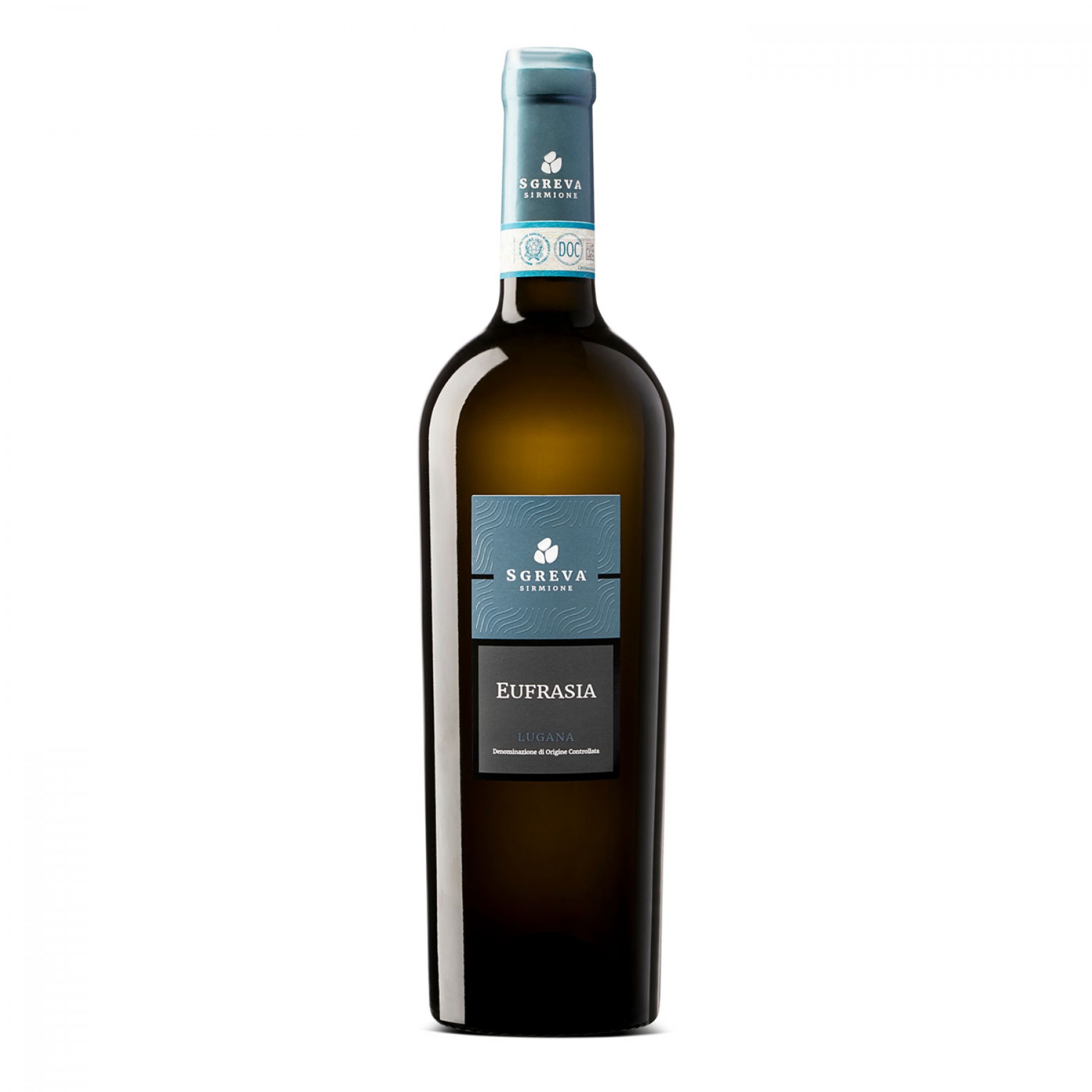 in northeastern Italy.
Two of the best are the 2017
Benedictus ($24) from Le Morette that’s made
from Turbiana grapes grown on a single vineyard
and has a bouquet and taste of toast and pears
with a crisp finish; and the 2018
Eufrasia ($23) from Sgreva, also
made from Turbiana grapes, that has a bouquet and
taste of ripe
honeydew melon with a soft, lemony finish.
in northeastern Italy.
Two of the best are the 2017
Benedictus ($24) from Le Morette that’s made
from Turbiana grapes grown on a single vineyard
and has a bouquet and taste of toast and pears
with a crisp finish; and the 2018
Eufrasia ($23) from Sgreva, also
made from Turbiana grapes, that has a bouquet and
taste of ripe
honeydew melon with a soft, lemony finish.
Although many
top-quality German Rieslings are too full-bodied
and/or too sweet to just sip with food, the 2018 Nik
Weiss St. Urban’s-Hof Dry Mosel Riesling
($21) has a bouquet and crisp flavor of ripe
pears, honey and lime with a zesty finish that
mates perfectly with salsa and other spicy hors
d’oeuvres.
And fans of
summertime seafare favorites Sancerre and New
Zealand Sauvignon Blanc (often too full-bodied to
sip on their own), should try the light, organic 2019 Domaine
Bosquet Sauvignon Blanc from Argentina ($22)
that has a bouquet and mild taste of grapefruit
and spice, with a crisp, refreshing finish.
And while Cantina
Montelliana is better known for its highly
acclaimed full-bodied Asolo DOCG Proseccos, they
produced a 2018
Treviso Prosecco Frizzante ($8) with just
a bit of fizz and a taste of vanilla and lemons
that’s perfect to pair with seafare or as an
apéritif.
❖❖❖
 THOSE MEXICANS
JUST CRACK THE AGAVE WITH THEIR HANDS AND
BREAK IT ALL UP!
THOSE MEXICANS
JUST CRACK THE AGAVE WITH THEIR HANDS AND
BREAK IT ALL UP!
Breaking Bad's co-stars
Bryan
Cranston and Aaron Paul are now marketing a new mezcal
brand called Dos Hombres, which they call "real,
artisanal Mezcal made by hand in Mexico."
SUFFER FROM INSOMNIA? 
READ THIS SNORE-INDUCING ARTICLE
“This paper highlights the social
significance of humor in everyday interactions with
food within families and related household contexts.
The paper approaches humor in relational terms,
emphasizing its role in negotiating the way power is
exercised within the moralized context of 'feeding the
family.' Having reviewed previous work on the social
significance of humor, the paper provides some
examples of food-related humor from recent research
with British food consumers, illustrating what such
occasions reveal about participants’ relations with
each other, with us as researchers, and with the food
they consume. Specifically, participants were found to
use apologetic and self-deprecating humor to negotiate
the moral ambiguities of food and to cover potentially
embarrassing situations; to express familiarity and
disgust regarding their current consumption practices;
and to excuse potentially shameful behavior or guilty
pleasures. The paper argues that an understanding of
the 'background disposition' through which consumers
make sense of their multiple encounters with food is
critical to the analysis of food-related humor and
that ethnographic methods are particularly adept at
revealing the social context in which humor
occurs.”—Peter Jackson, "Taking humor seriously in contemporary food
research," Food,
Culture & Society (2019)
Any of John Mariani's books below may be ordered from amazon.com.
 The Hound in Heaven
(21st Century Lion Books) is a novella, and
for anyone who loves dogs, Christmas, romance,
inspiration, even the supernatural, I hope you'll find
this to be a treasured favorite. The story
concerns how, after a New England teacher, his wife and
their two daughters adopt a stray puppy found in their
barn in northern Maine, their lives seem full of promise.
But when tragedy strikes, their wonderful dog Lazarus and
the spirit of Christmas are the only things that may bring
his master back from the edge of despair.
The Hound in Heaven
(21st Century Lion Books) is a novella, and
for anyone who loves dogs, Christmas, romance,
inspiration, even the supernatural, I hope you'll find
this to be a treasured favorite. The story
concerns how, after a New England teacher, his wife and
their two daughters adopt a stray puppy found in their
barn in northern Maine, their lives seem full of promise.
But when tragedy strikes, their wonderful dog Lazarus and
the spirit of Christmas are the only things that may bring
his master back from the edge of despair. WATCH THE VIDEO!
“What a huge surprise turn this story took! I was completely stunned! I truly enjoyed this book and its message.” – Actress Ali MacGraw
“He had me at Page One. The amount of heart, human insight, soul searching, and deft literary strength that John Mariani pours into this airtight novella is vertigo-inducing. Perhaps ‘wow’ would be the best comment.” – James Dalessandro, author of Bohemian Heart and 1906.
“John Mariani’s Hound in Heaven starts with a well-painted portrayal of an American family, along with the requisite dog. A surprise event flips the action of the novel and captures us for a voyage leading to a hopeful and heart-warming message. A page turning, one sitting read, it’s the perfect antidote for the winter and promotion of holiday celebration.” – Ann Pearlman, author of The Christmas Cookie Club and A Gift for my Sister.
“John Mariani’s concise, achingly beautiful novella pulls a literary rabbit out of a hat – a mash-up of the cosmic and the intimate, the tragic and the heart-warming – a Christmas tale for all ages, and all faiths. Read it to your children, read it to yourself… but read it. Early and often. Highly recommended.” – Jay Bonansinga, New York Times bestselling author of Pinkerton’s War, The Sinking of The Eastland, and The Walking Dead: The Road To Woodbury.
“Amazing things happen when you open your heart to an animal. The Hound in Heaven delivers a powerful story of healing that is forged in the spiritual relationship between a man and his best friend. The book brings a message of hope that can enrich our images of family, love, and loss.” – Dr. Barbara Royal, author of The Royal Treatment.
 |
The Encyclopedia of American Food and Drink by John F. Mariani (Bloomsbury USA, $35) Modesty forbids me to praise my own new book, but let me proudly say that it is an extensive revision of the 4th edition that appeared more than a decade ago, before locavores, molecular cuisine, modernist cuisine, the Food Network and so much more, now included. Word origins have been completely updated, as have per capita consumption and production stats. Most important, for the first time since publication in the 1980s, the book includes more than 100 biographies of Americans who have changed the way we cook, eat and drink -- from Fannie Farmer and Julia Child to Robert Mondavi and Thomas Keller. "This book is amazing! It has entries for everything from `abalone' to `zwieback,' plus more than 500 recipes for classic American dishes and drinks."--Devra First, The Boston Globe. "Much needed in any kitchen library."--Bon Appetit. |
"Eating Italian will never be the same after reading John Mariani's entertaining and savory gastronomical history of the cuisine of Italy and how it won over appetites worldwide. . . . This book is such a tasteful narrative that it will literally make you hungry for Italian food and arouse your appetite for gastronomical history."--Don Oldenburg, USA Today. "Italian
restaurants--some good, some glitzy--far
outnumber their French rivals. Many of
these establishments are zestfully described
in How Italian Food Conquered the World, an
entertaining and fact-filled chronicle by
food-and-wine correspondent John F.
Mariani."--Aram Bakshian Jr., Wall Street
Journal.
"Equal parts
history, sociology, gastronomy, and just
plain fun, How Italian Food Conquered the
World tells the captivating and delicious
story of the (let's face it) everybody's
favorite cuisine with clarity, verve and
more than one surprise."--Colman Andrews,
editorial director of The Daily
Meal.com. "A fantastic and fascinating
read, covering everything from the influence
of Venice's spice trade to the impact of
Italian immigrants in America and the
evolution of alta cucina. This book will
serve as a terrific resource to anyone
interested in the real story of Italian
food."--Mary Ann Esposito, host of PBS-TV's
Ciao
Italia. "John Mariani has written the
definitive history of how Italians won their
way into our hearts, minds, and
stomachs. It's a story of pleasure over
pomp and taste over technique."--Danny Meyer,
owner of NYC restaurants Union Square
Cafe, The Modern, and Maialino.
|
 |
 |
 |
 |
 |
 |
 |
 |
 Everett Potter's Travel Report:
Everett Potter's Travel Report: 
 Eating Las Vegas
JOHN CURTAS has been covering the Las Vegas
food and restaurant scene since 1995. He is
the co-author of EATING LAS VEGAS – The 50
Essential Restaurants (as well as
the author of the Eating Las Vegas web site: www.eatinglasvegas.
He can also be seen every Friday morning as
the “resident foodie” for Wake Up With the
Wagners on KSNV TV (NBC) Channel 3 in
Las Vegas.
Eating Las Vegas
JOHN CURTAS has been covering the Las Vegas
food and restaurant scene since 1995. He is
the co-author of EATING LAS VEGAS – The 50
Essential Restaurants (as well as
the author of the Eating Las Vegas web site: www.eatinglasvegas.
He can also be seen every Friday morning as
the “resident foodie” for Wake Up With the
Wagners on KSNV TV (NBC) Channel 3 in
Las Vegas.
MARIANI'S VIRTUAL GOURMET
NEWSLETTER is published weekly. Publisher: John Mariani. Editor: Walter Bagley. Contributing Writers: Christopher Mariani,
Robert Mariani, Misha Mariani, John A. Curtas, Gerry Dawes, Geoff Kalish,
and Brian Freedman. Contributing
Photographer: Galina Dargery. Technical
Advisor: Gerry
McLoughlin.
If you wish to subscribe to this
newsletter, please click here: http://www.johnmariani.com/subscribe/index.html
© copyright John Mariani 2019

